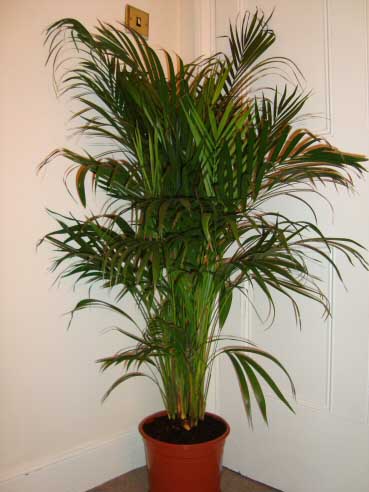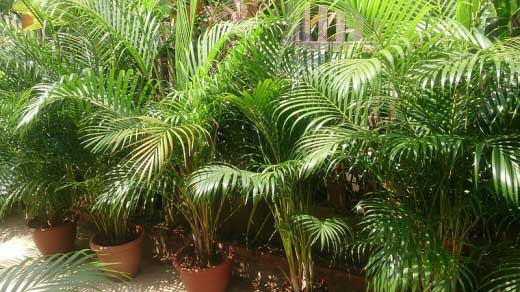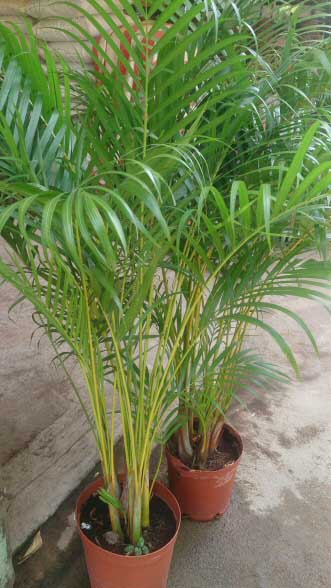





The Areca Palm or Butterfly Palm is a relatively easy care indoor houseplant that has much going for it.  Its attractive nature has been awarded the Royal Horticultural Society's Award of Garden Merit, which for a plant grown more commonly indoors than out, is a pretty rare feat.
Its attractive nature has been awarded the Royal Horticultural Society's Award of Garden Merit, which for a plant grown more commonly indoors than out, is a pretty rare feat.
It goes by many names - Areca lutescens, Chrysalidocarpus lutescens, Dypsis lutescens, Butterfly Palm (because the fronds resemble butterflies), Yellow Palm, Golden Cane (because the lower canes have a gold / yellow colour) and of course Areca Palm.
The three most well known and popular indoor palms are the Sentry / Kentia Palms, the Parlour / Parlor Palm and the Areca Palm, of these perhaps the Areca Palm is the most difficult, however even then it's not that hard. Appearance wise It can easily be separated from other types of palms because of its narrow, numerous full fronds arranged close to one another in neat compact lines along the stems. The other types mentioned above have wider and more sparse fronds which means all three have a distinct appearance when compared side by side.
The Areca Palm's popularity as an office and houseplant increased (and is maintained today) in part because of the air cleaning experiments carried out by NASA and Dr Wolverton in the 1980's. 50 plants were tested for their ability to filter the air around us, ease of care and ability to add moisture to the surrounding atmosphere. The Areca Palm took first place scoring highly in all categories meaning it was ranked the best houseplant at cleaning the air in our homes and offices.

Bold, attractive, easy to care for, desirable and positive for our health. So what's not to like? The fashion for these plants is that "bigger is better" and this has persisted over the last few decades. Which means because few people want to buy small Areca's, few people actually sell them. Therefore you can only really buy these palms in a large size and this results in firstly needing the actual space to home one and an initial financial outlay. In fact, they may be one of the most expensive houseplants you can buy second only to Orchids.
If you're brand new to houseplants you might want to wait until your green thumb has greened up a little, as it would be a shame to lose one through poor treatment or care resulting from inexperience. However if you're confident, have the space and want something striking, the Areca Palm or Butterfly Palm is a plant you will definitely want on your shortlist.
Light
Areca Palm's will accept a spot which doesn't receive any sunlight at all during the day and equally it will accept direct sun, however it doesn't like excessive amounts of either. Very dark shady areas and constant direct sunlight need to be avoided. The best approach for this palm is therefore to meet it half way by placing it in a bright spot which receives no direct sunlight or only small amounts either in the morning or evening.
Watering
Natively Areca Palms come from the tropics so they're used to regular daily tropical showers and having their roots in constantly damp soil. With this in mind the ideal watering requirements would be to ensure the soil is moist for much of the time.
In Spring, Summer and Autumn / Fall, this palm has a thirst which requires you to water heavily and often during the height of Summer. If you have chosen the ideal spot mentioned in the "light" section above and it's very warm then you could be watering twice a week.
Despite the desire for moisture, too much water will end your plant quite quickly. It's best therefore to ensure the surface soil has dried out before you water again. The occasional draught will be tolerated so if you're concerned it's not been long since you last watered, wait a few more days. Use rain water if you have access to it, to avoid a fluoride build up and as always with houseplants ensure you reduce the amount of water you give in the cool Winter months.
It's true that the Areca Palm has a thirst, but don't overdo it!
Humidity
Unfortunately humidity, or rather a lack of it, can be an issue on occasion for these palms as they do thrive in high humidity. If you experience a lot of dry air in your home you may get the Red Spider Mite pest and brown tips on the end of the fronds. The fix is to raise the humidity by misting the palm, using a pebble tray, or by relocating the entire plant to somewhere more humid.
Feeding
A general all purpose feed every month or so (except in Winter when you shouldn't give any) is all you need to provide.
Temperature
Warmer temperatures are fantastic for this palm, but this is normally hard to obtain in the average home. Don't worry to much though as average warmth is all that's required for growth so try to provide temperatures between 15°C - 25°C / 59 °F - 70°F. Take care not to allow it to get any colder than 10°C / 50°F to keep your plant healthy.
Repotting
Palms do not like constant root disturbance so a lot of regular repotting can cause damage and stop your Areca growing. However as they do not grow very fast, repotting isn't something you need to be doing often anyway. Once every couple of years would be usual here, although if you do manage to secure a really young plant you might need to grow it on by repotting once every year in Spring until it reaches maturity. When you come to do it, normal potting soil is absolutely fine.
Propagation
Two words when it comes to propagating the Areca Palm - don't bother. Almost all indoor palms are too difficult and demanding to be propagated realistically by the average indoor gardener.  When you factor in the cost of the equipment that you'll need (as well as the cost of running it) to ensure successful seed germination it's almost always cheaper to buy a new plant or divide an existing one if you want another.
When you factor in the cost of the equipment that you'll need (as well as the cost of running it) to ensure successful seed germination it's almost always cheaper to buy a new plant or divide an existing one if you want another.
Speed of Growth
Growth is slow even if the ideal conditions are provided so cheat by buying the biggest plant you can afford at purchase time.
Height / Spread
Few indoor specimens will ever surpass 3 m (10 ft) in height.
Flowers
Expect no flowers on this palm if kept indoors no matter how well you care for it.
Anything else?
Avoid heavy use of leaf shine products on Areca Palms as they can damage the leaves. So instead just use a damp cloth or give it a quick shower every few months to remove the dust and keep the leaves looking green and lush.
Copyright © www.100flowers.win Botanic Garden All Rights Reserved